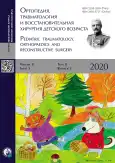Foot abduction brace noncompliance in children with idiopathic clubfoot: how the deep squatting posture might help
- Authors: Sailohit P.1, Limpaphayom N.2
-
Affiliations:
- Police General Hospital
- Chulalongkorn University
- Issue: Vol 8, No 3 (2020)
- Pages: 241-248
- Section: Original Study Article
- URL: https://bakhtiniada.ru/turner/article/view/25856
- DOI: https://doi.org/10.17816/PTORS25856
- ID: 25856
Cite item
Abstract
Background. Compliance with the foot abduction brace (FAB) is essential for idiopathic clubfoot (ICF) managed by the Ponseti method. The deep squatting posture (DSP) was correlated with favorable outcomes in ICF.
Aim. The aims of the study were to identify the noncompliance rate with the FAB, and assess how the routine practice of ankle stretching and Asian-style DSP affected the ICF correction during the Ponseti method.
Materials and methods. Of 42 children with ICF, 63 ICF underwent the Ponseti method at an average age of 8.7 ± 12.6 weeks using an average of 5.4 ± 1.7 casts followed by FAB wear. The children practiced the DSP exercise as an adjunct to the FAB protocol. Children noncompliant with the FAB protocol but compliant with the DSP exercise (group A) were compared with children noncompliant with both FAB protocol and DSP exercise (group B).
Results. At an average follow-up of 3.5 ± 1.4 years, 8 of 42 children compliant with the FAB protocol. The FAB protocol deviation was documented at an average of 10.3 ± 4.8 months. Children who did not adhere to the practice of the DSP exercise had a higher recurrent rate of any ICF deformity (OR 7.82, 95% CI 1.35–53.79, p = 0.003). Of the 34 children (48 feet) noncompliant with FAB, the children in group A (39 feet) had lower recurrence rate (p = 0.02), a better Dimeglio grade (p = 0.005), and a better Pirani score (p < 0.001) at the most recent evaluation than children in group B (nine feet). However, recurrent metatarsus adductus was more prevalent in group A.
Conclusion. The DSP exercise should be advocated as a supplemental modality but cannot substitute the regular use of FAB.
Full Text
##article.viewOnOriginalSite##About the authors
Pipattra Sailohit
Police General Hospital
Email: fasai5443@gmail.com
ORCID iD: 0000-0002-7013-531X
Department of Orthopaedics
Thailand, Pathumwan, Bangkok 10330Noppachart Limpaphayom
Chulalongkorn University
Author for correspondence.
Email: noppachart.l@chula.ac.th
ORCID iD: 0000-0002-7931-7857
Scopus Author ID: 24461512000
Department of Orthopaedics, Faculty of Medicine
Thailand, 1873 Rama 4 Road, Pathumwan, Bangkok 10330References
- Dobbs MB, Rudzki JR, Purcell DB, et al. Factors predictive of outcome after use of the Ponseti method for the treatment of idiopathic clubfeet. J Bone Joint Surg Am. 2004;86(1):22-27. https://doi.org/10.2106/00004623-200401000-00005.
- Miller NH, Carry PM, Mark BJ, et al. Does strict adherence to the Ponseti method improve isolated clubfoot treatment outcomes? A two-institution review. Clin Orthop Relat Res. 2016;474(1):237-243. https://doi.org/10.1007/s11999-015-4559-4.
- Zhao D, Liu J, Zhao L, Wu Z. Relapse of clubfoot after treatment with the Ponseti method and the function of the foot abduction orthosis. Clin Orthop Surg. 2014;6(3):245-252. https://doi.org/10.4055/cios.2014.6.3.245.
- Ponseti.info [Internet]. Bracing Tips [cited 2019 Mar 31]. Available from: http://www.ponseti.info/bracing-tips.html.
- Dobbs MB, Frick SL, Mosca VS, et al. Design and descriptive data of the randomized Clubfoot Foot Abduction Brace Length of Treatment Study (FAB24). J Pediatr Orthop B. 2017;26(2):101-107. https://doi.org/10.1097/BPB.0000000000000387.
- Morgenstein A, Davis R, Talwalkar V, et al. A randomized clinical trial comparing reported and measured wear rates in clubfoot bracing using a novel pressure sensor. J Pediatr Orthop. 2015;35(2):185-191. https://doi.org/10.1097/BPO.0000000000000205.
- Panjavi B, Sharafatvaziri A, Zargarbashi RH, Mehrpour S. Use of the Ponseti method in the Iranian population. J Pediatr Orthop. 2012;32(3):e11-14. https://doi.org/10.1097/BPO.0b013e318237c17e.
- Evans AM, Chowdhury MMH, Kabir MH, Rahman MF. Walk for life — the National Clubfoot Project of Bangladesh: The four-year outcomes of 150 congenital clubfoot cases following Ponseti method. J Foot Ankle Res. 2016;9(1). https://doi.org/10.1186/s13047-016-0175-0.
- Das De S, Balasubramaniam P, Bose K. Squatting posture in Asians and development of the inferior hip ‘sourcil’. J Orthop Surg. 1994;2(2):33-37.
- Kasuyama T, Sakamoto M, Nakazawa R. Ankle joint dorsiflexion measurement using the deep squatting posture. J Phys Ther Sci. 2009;21(2):195-199. https://doi.org/10.1589/jpts.21.195.
- Perveen R, Evans AM, Ford-Powell V, et al. The Bangladesh Clubfoot Project. J Pediatr Orthop. 2014;34(7):720-725. https://doi.org/10.1097/bpo.000 0000000000225.
- Limpaphayom N, Tooptakong T, Osateerakun P. A comparative study of pedobarography and ankle kinematics between children with idiopathic clubfoot after a soft tissue release procedure and controls. Int Orthop. 2020;44(2):319-327. https://doi.org/10.1007/s00264-019-04447-2.
- Agarwal A, Gupta S. Letter to the Editor Brace compliance in clubfoot: Clinical signs. J Clin Orthop Trauma. 2020;11(2):344-346. https://doi.org/10.1016/j.jcot. 2019.01.022.
- Avilucea FR, Szalay EA, Bosch PP, et al. Effect of cultural factors on outcome of Ponseti treatment of clubfeet in rural America. J Bone Joint Surg Am. 2009;91(3):530-540. https://doi.org/10.2106/JBJS.H.00580.
- Chen RC, Gordon JE, Luhmann SJ, et al. A new dynamic foot abduction orthosis for clubfoot treatment. J Pediatr Orthop. 2007;27(5):522-528. https://doi.org/10.1097/bpo.0b013e318070cc19.
- Hemo Y, Segev E, Yavor A, et al. The influence of brace type on the success rate of the Ponseti treatment protocol for idiopathic clubfoot. J Child Orthop. 2011;5(2):115-119. https://doi.org/10.1007/s11832-010-0321-3.
- Niki H, Nakajima H, Hirano T, et al. Effect of Achilles tenotomy on congenital clubfoot-associated calf-muscle atrophy: An ultrasonographic study. J Orthop Sci. 2013;18(4):552-556. https://doi.org/10.1007/s00776-013-0398-x.
- Trofimova SI, Derevianko DV, Kochenova EA, Petrova EV. Effectiveness of achillotomy in children with arthrogryposis. Pediatric Traumatology, Orthopaedics and Reconstructive Surgery. 2019;7(2):51-60. https://doi.org/10.17816/ptors7251-60.
- Kato E, Kanehisa H, Fukunaga T, Kawakami Y. Changes in ankle joint stiffness due to stretching: The role of tendon elongation of the gastrocnemius muscle. Eur J Sport Sci. 2010;10(2):111-119. https://doi.org/10.1080/17461390903307834.
- Herda TJ, Herda ND, Costa PB, et al. The effects of dynamic stretching on the passive properties of the muscle-tendon unit. J Sports Sci. 2013;31(5):479-487. https://doi.org/10.1080/02640414.2012.736632.
Supplementary files










